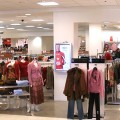Department Stores
Though the Hudson's Bay Company of Canada began operations as far back as 1670, and was in fact a store with "departments," it is not clear when the Hudson's Bay Company could safely be classified as a "department store." In 1838, on the other side of the world, the city Paris saw the opening of a small market emporium selling a variety of goods under one single roof. The store was offering a one-stop shopping experience. This store offering a "one-stop shopping experience" was in fact the progenitor of what was to become the Bon Marche. By 1852, the Bon Marche was known throughout France and offered a wide variety of goods sold in its segregated "departments." The goods were sold at a fixed price, with guarantees allowing exchanges and refunds.
Back across the Atlantic, in the city of New York, an Irish-born entrepreneur named A.T. Stewart established the prototype of the US-styled department store on the east side of Broadway, between Chambers and Reade Streets, in 1846. He offered European retail merchandise at set prices on a variety of dry goods. He advertised a policy of providing "free entrance to all potential customers." Though it was clad in white marble to look like a Renaissance palazzo, the building's cast iron construction permitted large plate glass windows which gave passers-by a chance to shop before they had made their entrance. More significantly, it tempted passerby with no inclination towards shopping to at least stop to see what was for sale. Window shopping was born; and if windows were what the window-shopper was looking for, A.T. Stewart had a department for those too.
In 1862 Stewart built a true department store on a full city block at Broadway and 9th Street, opposite Grace Church, with eight floors and 19 departments of dress goods and furnished materials, carpets, glass and china, toys and sports equipment, all arranged around a central glass-covered court. Within two decades, New York's retail center had shifted uptown, forming a retail shopping area stretching from A.T. Stewart's department store and covering the areas of 23rd Street, Broadway and much of Sixth Avenue. This district quickly earned the moniker "the Lady's Mile" due to the high number of ladies who shopped there. Macy's was founded as a dry goods store by Rowland Hussey Macy in 1858. Benjamin Altman and Lord & Taylor soon competed with Stewart as New York's premier department stores. Many of the grand buildings of the 1880s and 1890s remain today but, due to market forces and the age-old inclination to compete and destroy one's competition, have new tenants and serve new uses. Similar developments were under way in London with "Liberty and Company," and in Paris with "La Samaritan." In Chicago, department stores quickly sprang up along Michigan Avenue-most notably "Marshall Field and Company" which is today simply known as Marshall Field's. In 1877, Philadelphia's John Wanamaker redeveloped the former Pennsylvania Railroad terminal in that city and eventually opened a department store in that very building. The principle behind a department store-namely having one single space where a customer could shop for all needed items in an enclosed area out of the elements-remains with us, and this constant principle has given rise to the department stores we use so frequently today.
There has however, been some degree of evolution. The habit of sole ownership and control of all items sold and services offered at department stores has diminished in recent years. Most of the more specialized departments are now leased out to smaller businesses whose acumen at their task and reputation for quality only enhances that department store's reputation. Photography and photo finishing, automotive services and financial services are generally controlled by outside firms who lease the space from which they conduct their specialized business. Restaurants, too, are often given over to better known food industries.
Some elements of department stores which may seem like recent modifications are in fact as ancient as the beginning of the store itself. Virtually all the initial department stores featured food courts, areas for resting and/or entertainment, child-minding areas and kiosks. The concept behind the department store is as popular today as those who initiated the idea of a one-stop shopping arena hoped it would be centuries ago; and with the recent stellar success of places such as Sears and Wal-Mart, for good or ill, department stores will be around as long as there are people with pockets full of cash and a disinclination to cross the street for a better deal.

